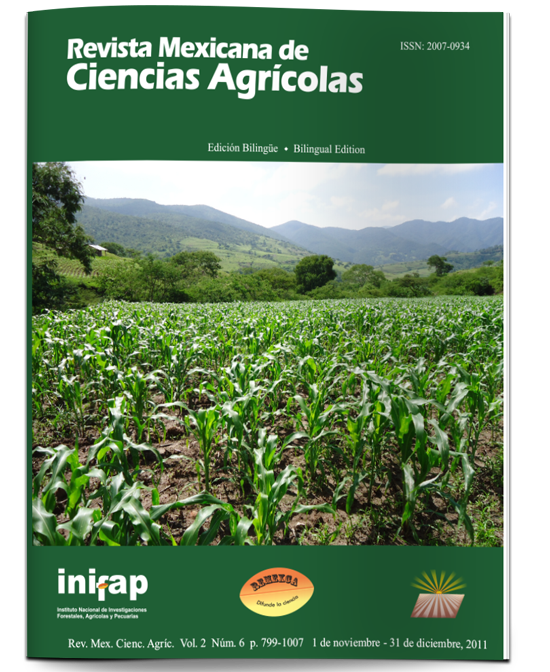PINTO BRAVO: A NEW DRY BEAN VARIETY FOR THE SEMIARID MEXICAN HIGHLANDS
DOI:
https://doi.org/10.29312/remexca.v2i6.1600Keywords:
Phaseolus vulgaris L., commercial quality, improved variety, yieldAbstract
In the Semiarid Highlands of Mexico, the pinto bean is one of the main commercial classes produced under rainfed conditions. It’s required grain-tolerant varieties of the seed coat darkening, early maturity and larger seeds in relation to Pinto Saltillo’s, which is the most popular variety in the region. The objective was to develop a superior bean variety than Pinto Saltillo in earliness, grain size and commercial quality. The staff of the National Research Institute for Forestry, Agriculture and Livestock generated in Durango, the Pinto Bravo variety, using the genealogical method from the cross between Pinto Mestizo and Pinto Saltillo [(Pinto Mestizo/Pinto Saltillo)-7-4]. This variety showed an average yield of 1 178 kg ha-1 and a fluctuation between 329 kg ha-1 and 3 045 kg ha-1. On average, Pinto Bravo compared with Pinto Saltillo, had more precocious maturity (88 vs 93 days) and had greater weight of 100 seeds (36 g vs 31 g). The growth habit of Pinto Bravo is indeterminate vine, with short no- climbing guides, canopy average height of 27 cm and 75 cm guide. Pinto Bravo has an average weight of 36 g/100 seeds and variations between 25 and 46 g per 100 seeds. The grain shape is transversally elliptic and elliptical rhomboid in the external view. The head is creamy color, light brown speckles and yellow hilum. Pinto Bravo has tolerance to anthracnose and rust; as well as medium and high values of susceptibility to common blight and root rots. This variety is currently being validated on producers land and seeds will be reproduced to establish their suitability and potential, in order to increase the commercial quality of beans produced in the semi-arid highlands of Mexico.
Downloads
Downloads
Published
How to Cite
Issue
Section
License
The authors who publish in Revista Mexicana de Ciencias Agrícolas accept the following conditions:
In accordance with copyright laws, Revista Mexicana de Ciencias Agrícolas recognizes and respects the authors’ moral right and ownership of property rights which will be transferred to the journal for dissemination in open access. Invariably, all the authors have to sign a letter of transfer of property rights and of originality of the article to Instituto Nacional de Investigaciones Forestales, Agrícolas y Pecuarias (INIFAP) [National Institute of Forestry, Agricultural and Livestock Research]. The author(s) must pay a fee for the reception of articles before proceeding to editorial review.
All the texts published by Revista Mexicana de Ciencias Agrícolas —with no exception— are distributed under a Creative Commons License Attribution-NonCommercial 4.0 International (CC BY-NC 4.0), which allows third parties to use the publication as long as the work’s authorship and its first publication in this journal are mentioned.
The author(s) can enter into independent and additional contractual agreements for the nonexclusive distribution of the version of the article published in Revista Mexicana de Ciencias Agrícolas (for example include it into an institutional repository or publish it in a book) as long as it is clearly and explicitly indicated that the work was published for the first time in Revista Mexicana de Ciencias Agrícolas.
For all the above, the authors shall send the Letter-transfer of Property Rights for the first publication duly filled in and signed by the author(s). This form must be sent as a PDF file to: revista_atm@yahoo.com.mx; cienciasagricola@inifap.gob.mx; remexca2017@gmail.
This work is licensed under a Creative Commons Attribution-Noncommercial 4.0 International license.



